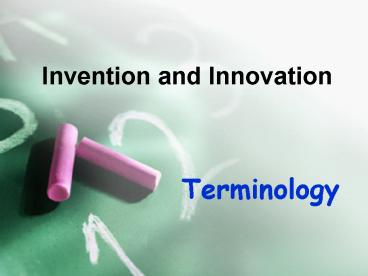Invention and Innovation - PowerPoint PPT Presentation
1 / 22
Title:
Invention and Innovation
Description:
In the 1870s, two inventors Elisha Gray and Alexander Graham ... 4) The Automobile. 5) The Cotton Gin. 6) The Camera. 7) The Steam Engine. 8) The Sewing Machine ... – PowerPoint PPT presentation
Number of Views:389
Avg rating:3.0/5.0
Title: Invention and Innovation
1
Invention and Innovation
- Terminology
2
Invention
- A new product
or system
or process that has never existed
before, created by study and experimentation.
3
Invention
- One of the top inventions of all times was
the Telephone.
In the 1870s, two inventors
Elisha Gray and Alexander
Graham Bell both independently
designed
devices that could transmit speech electrically
(the telephone). Both men rushed their respective
designs to the patent office within hours of each
other, Alexander Graham Bell patented his
telephone first.
4
Invention
- Another popular invention was the Light Bulb!
5
Invention
- Contrary to popular belief, Thomas Alva
Edison didn't "invent" the light bulb,
but rather he improved
upon a 50-year-old idea.
In 1809, Humphry Davy, an English chemist,
invented the first electric light. In 1879,
Thomas Alva Edison invented a carbon filament
that burned for forty hours.
6
Innovation
- An improvement of an existing technological
product, system, or method of doing something.
7
Innovation
- A very popular innovation today is the Cell
Phone.
In 1979, the first commercial cellular phone
system began operation in Tokyo. -- By the end of
2004, the number of wireless subscribers in the
USA surpassed 180.5 million.
8
Innovation Involves
- Being Creative!
- Making New Things!
9
Patent
- A patent for an invention is the grant of a
property right to the inventor, issued by the
United States Patent and Trademark
Office. - Generally, the term of a new patent is 20 years
from the date on which the application for the
patent was filed in the United States.
10
Patent
- Patent Pending or Patent Applied For are phrases
that often appears on manufactured items. It
means that someone has applied for a patent on an
invention that is contained in the manufactured
item.
On November 15, 1904, patent 775,134 was granted
to King C. Gillette for a safety 'razor'.
11
Serendipity
- An accidental discovery!
- Some inventions come about accidentally.
12
Serendipity
- Charles Goodyears (1800
-1860) name is now part of the
Goodyear Tire Rubber Company. - He was working for years on how to vulcanize (or
strengthen) rubber without much success until he
accidentally dropped a bit of rubber with some
sulfur onto a hot stove.
13
Design
- It is the creative
planning process that leads to
useful products and systems. - Designers plan and conceive ideas in their
minds. - Design can also refer to making drawings,
patterns, or sketches. - One type of design is called Engineering
Design.
14
The Design Loop
- Different tasks to be completed
- Suggested, rather than prescriptive
- Identify the problem
- Investigating
- Developing ideas
- Refining the idea
- Modeling/prototyping
- Evaluating/assessing
- Communicating
15
1. Understand the Problem
- Before solving the problem, we must
- Analyze the situation
- Determine what is the actual problem?
- Define the problem
- Understand the problem
16
2. Investigate the Problem
- Explore possible alternative solutions
- Conduct research
- Past experiences and knowledge
- Observations (examine similar problems/solutions)
- Talk with others with the same type problem
- (interviews, telephone calls,
- e-mail)
- Search for new information
- (books, Internet, search of
- similar products)
- Explore community resources
- (shops, businesses, museums,
- industries)
17
3. Develop Ideas Potential Solutions
- Ask questions!
- Brainstorm
- Generate multiple ideas
- Think of consequences
- Identify alternatives
- Consider constraints
- Consider limits
- Consider specifications
- Consider risks/benefits
18
4. Refine Detail Ideas
- Sketches and drawings
- Combining/separating
- ideas
- Evaluate pros cons of
- different ideas
- Idea selection
- Creating rough and final drawings
19
5. Mock-ups, Models Prototypes
- Models give a representation of final product
- Models give a chance to make last minute changes
- Prototype is the first working version of product
- Test prototypes and refine product
- Finally mass produce product
20
6. Evaluation Assessment
- Testing the solution
- Did the product/system solve the problem?
- Evaluating the process
- What could be changed in the future?
- Is the proposed solution the simplest possible?
21
7. Communication
- Recording and presenting the idea
- Drawings, sketches, graphs, materials lists
- Documentation of
- Major steps
- Materials/techniques used
- Discarded ideas
- Demonstration of proposed
- solution
- Future changes/ideas
- Important for those who will use
- your ideas in the future
22
Top 10 Inventions About .Com
- Here are the most popular inventions researched
by their readers. - 1) The Telephone
- 2) The History of Computers
- 3) Television
- 4) The Automobile
- 5) The Cotton Gin
- 6) The Camera
- 7) The Steam Engine
- 8) The Sewing Machine
- 9) The Light Bulb
- 10) Penicillin































